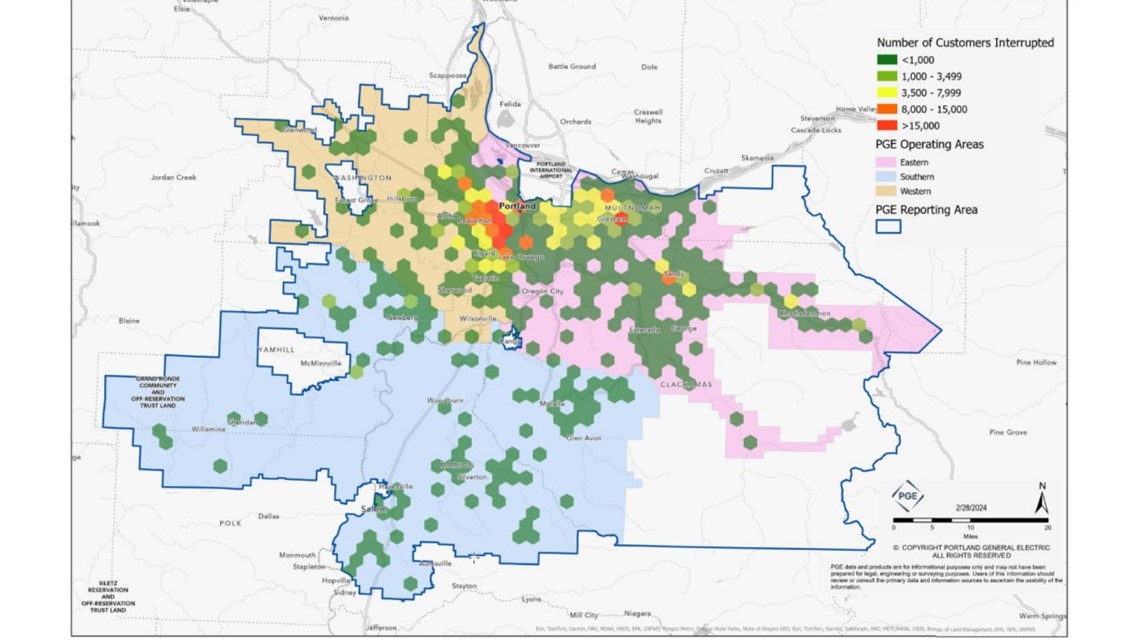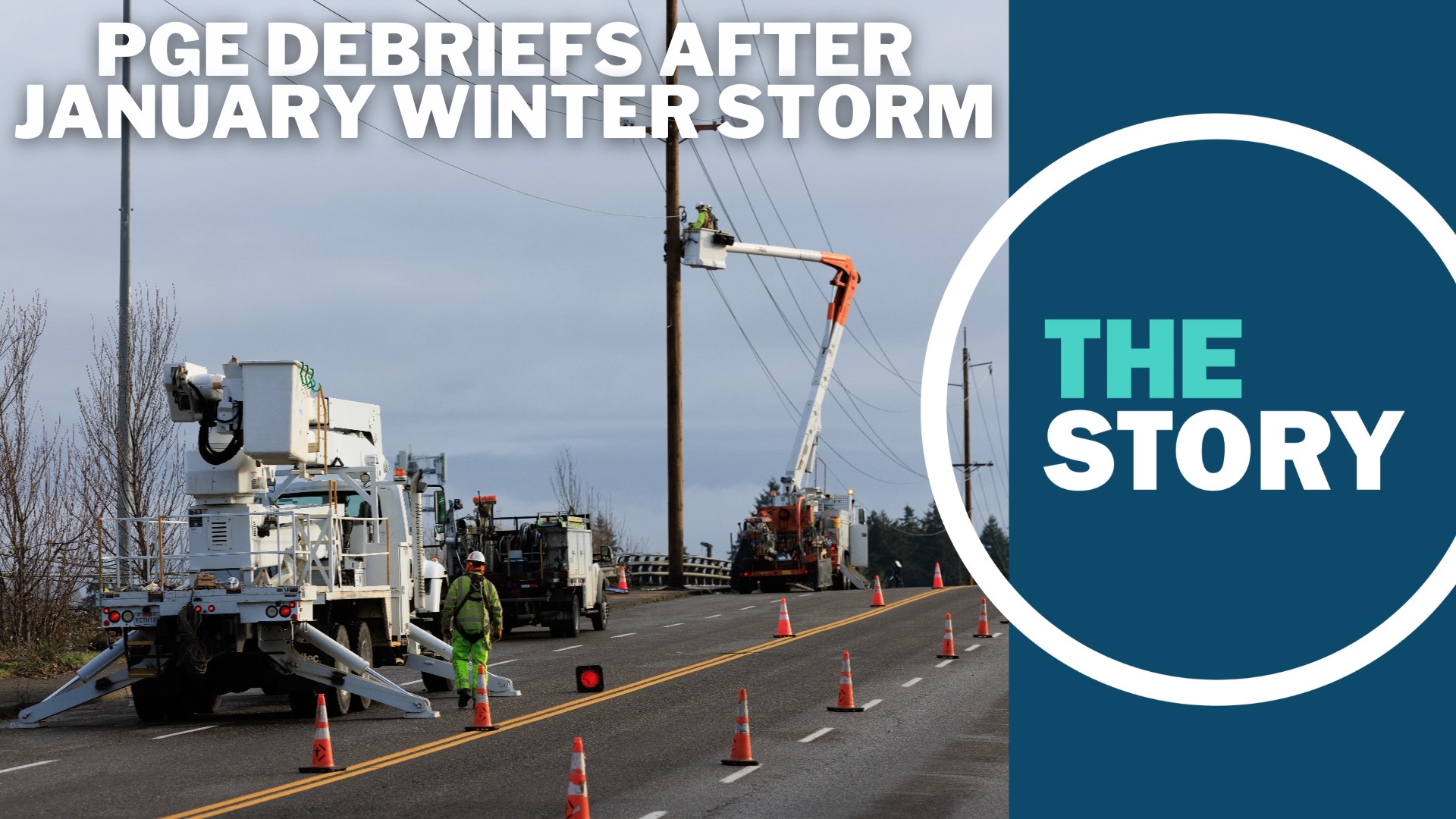PORTLAND, Ore. — Once the clouds lift, the streets thaw and power gets restored after a winter storm, it's easy to move on and forget just how impactful it was. The ice storm that hit the Portland metro area in January left hundreds of thousands of people without heat amid below-freezing temperatures — some of them for roughly a week.
The snow, ice and winds took out 850 distribution lines owned by Portland General Electric. Over the course of that week, the utility said that 440,000 customers lost power. About 146,000 Pacific Power customers lost power as well.
At least 10 deaths were linked to winter weather-related causes during that week — five believed to be from hypothermia and the others from downed trees, power lines or fires.
On Monday, PGE released a formal report required by the Oregon Public Utility Commission which breaks down what happened during the storm and how it responded.
The utility company reports that as the storm arrived, high winds knocked out power to about 270,000 customers in the first wave. More outages came and went as the storm progressed. Many outages from the first day had been resolved when a third wave of the storm came through Jan. 19, causing another spike in outages that persisted for about two days.
The storm ultimately lasted a week, from Jan. 13 through Jan. 20, with waves of wind, snow and ice hitting the area. About 109,000 customers lost power multiple times during that period. The hardest hit areas were in Beaverton, Tigard and Lake Oswego.


In response to customer complaints about poor communication during those outages, PGE said that it was hard for crews to access some areas during the storm, making it difficult to give estimates on when power would be restored.
RELATED: After big rate hike, PGE customers may also be on the hook for winter storm power restoration work
Pump up the rates
After the storm had passed, many PGE customers got a rude awakening when their bills arrived. Not only did the bitter cold of that week result in higher heating costs, but the company received approval late last year for a rate hike of about 18%, taking effect in the new year and first appearing on those January statements.
And the utility company has already signaled that they want to raise rates even higher. In a new filing, the company requested another hike of 7.3%. The company argues that it deserves to make a 9.75% rate of return, and that won't happen without another increase in what customers pay.
The company also wants a new mechanism to ask for more frequent rate hikes in order to pay for safety and resiliency work on its system.
The Story's Pat Dooris reached out to PGE for an interview with CEO Maria Pope, but she was not available to talk Monday. On the other side of the issue is Bob Jenks from the Oregon Citizens' Utility Board, a watchdog group representing consumers. He didn't think highly of PGE's request.
"The most incredible thing is they want a new rate making mechanism that allows them to raise rates every January for billions of dollars in capital investment with a very limited review by the PUC and stakeholders like CUB," Jenks said. "Without any ability to look at profits and see whether shareholders should help pay for this."
Pushed to the limit
In its filings, PGE points out that it is investing in two huge battery storage operations in the Portland area that will store up to four hours of electricity and power as many as 260,000 homes.
And then there is the impact of climate change and the shift toward clean energy, which plays a role in the need to raise rates, according to the company. During testimony to the PUC, Pope said that there are now more days where electricity is needed to cool our homes and businesses and days where it's needed to heat them, leading to more demand.
"Before 2022, PGE's peak load record held for nearly 25 years," Pope said. "Now we are seeing new records set almost annually, with a new winter peak load record set in December 2022 and new summer and all time system peaks set in June 2021, and then again in August 2023."
At the same time that the climate is fluctuating more wildly, coal plants around the Western U.S. are being shut down. The plants are dirty and bad for the environment, but they've also been dependable sources of electricity. As those plants close down, there are fewer reliable sources of electricity during big weather events, PGE said.
"As utilities through out our region embrace new clean energy technologies and beneficial electrification to reduce carbon emissions, regional capacity supply has tightened and frequently reaches critical levels during peak events," Pope said. "And energy prices regularly rise to unprecedented levels during high-demand periods."
The January storm was the coldest the region's been in 30 years, Pope said, and it stressed the electrical grid to the extreme.
"This regional weather event created extremely high and volatile wholesale energy market prices," she said.
For example, Pope said, one market charged $1,000 per megawatt hour. But the massive California Independent System Operator charged $2,000 — double the cost for the same amount of energy.
Regional electric supplies were stretched to deficit levels, so there simply wasn't enough to go around. Several other utilities had to declare an energy emergency, Pope said, although she did not elaborate on which ones those were.

